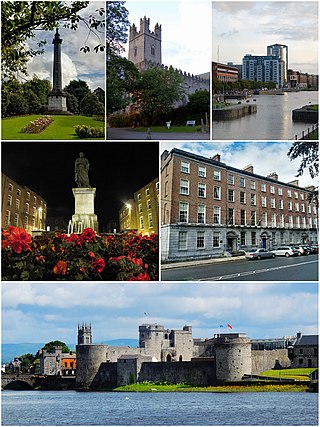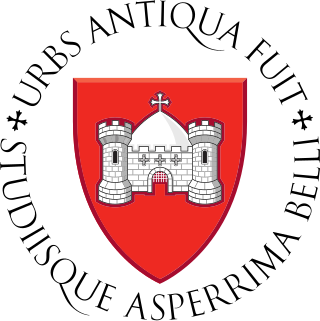
A borough is an administrative division in various English-speaking countries. In principle, the term borough designates a self-governing walled town, although in practice, official use of the term varies widely.

Limerick is a city in western Ireland, in County Limerick. It is in the province of Munster and is in the Mid-West which comprises part of the Southern Region. With a population of 102,287 at the 2022 census, Limerick is the third-most populous urban area in the Republic of Ireland, and the fourth-most populous city on the island of Ireland. It was founded by Scandinavian settlers in 812, during the Viking Age.

County Waterford is a county in Ireland. It is in the province of Munster and is part of the Southern Region. It is named after the city of Waterford. Waterford City and County Council is the local authority for the county. The population of the county at large, including the city, was 127,363 according to the 2022 census. The county is based on the historic Gaelic territory of the Déise. There is an Irish-speaking area, Gaeltacht na nDéise, in the southwest of the county.

Ennis is the county town of County Clare, in the mid-west of Ireland. The town lies on the River Fergus, north of where the river widens and enters the Shannon Estuary. Ennis is the largest town in County Clare, with a population of 27,923, making it the 6th largest town, and 11th largest urban settlement, as of the 2022 census. Dating from the 12th century the town's Irish name is short for Irish: Inis Cluana Rámhfhada, meaning "Island of the long rowing meadow", deriving from its location between two courses of the River Fergus.

Raheen is a large suburb of Limerick, Ireland. Initially developed to ease population overspill from the city of Limerick, Raheen is socioeconomically diverse, ranging from older, poor-class housing estates to relatively affluent areas.

The functions of local government in the Republic of Ireland are mostly exercised by thirty-one local authorities, termed County, City, or City and County Councils. The principal decision-making body in each of the thirty-one local authorities is composed of the members of the council, elected by universal franchise in local elections every five years from multi-seat local electoral areas using the single transferable vote. Many of the authorities' statutory functions are, however, the responsibility of ministerially appointed career officials termed Chief executives. The competencies of the city and county councils include planning, transport infrastructure, sanitary services, public safety and the provision of public libraries. Each local authority sends representatives to one of three Regional Assemblies.

The N20 road is a national primary road in Ireland, connecting the cities of Cork and Limerick. Buttevant, Croom, Charleville, Mallow and Blarney are major towns along the route. A short section of the route is motorway standard and is designated as the M20 Motorway.
The Crescent Shopping Centre is a major shopping centre serving Limerick, Ireland. It is located in Dooradoyle, on the southern outskirts of the city. The complex in its original form was opened in 1973, making it one of the earlier shopping centres to open in Ireland. It has an estimated 100,000 m2 (1,100,000 sq ft) of space, 2,500 free car parking places and 94 shops. The shopping centre takes its name from the adjacent Crescent College, whose original building was in The Crescent in the city centre.

Limerick City Council was the local authority of the city of Limerick in Ireland. The council had 17 elected members. The head of the council had the title of mayor. Limerick City Council was the smallest local government area in Ireland by area (20.35 km2) and 30th in terms of population. It was abolished in 2014 when the Local Government Reform Act 2014 was implemented. It was succeeded by Limerick City and County Council.

Cork County Council is the local authority of County Cork, Ireland. As a county council, it is governed by the Local Government Act 2001, as amended. The council is responsible for housing and community, roads and transportation, urban planning and development, amenity and culture, and environment. The council has 55 elected members. Elections are held every five years and are by single transferable vote. The head of the council has the title of Mayor. The county administration is headed by a Chief Executive, Valerie O'Sullivan. The county seat is Cork.
The Chief Executive of a city or county is the senior permanent official in local government in the Republic of Ireland. Whereas the county council and city council are elected officials who formulate policy, the chief executive is an appointed official who manages the implementation of policy. The position was introduced in 1929–42 based on the American council–manager government model, and until 2014 the chief executive was styled the county manager or city manager. Their salaries range from €132,511 to €189,301 per annum. The County and City Management Association is the professional association for chief executives, and it is affiliated to the International City/County Management Association (ICMA).

Fingal County Council is the local authority of the county of Fingal, Ireland. It is one of three local authorities that succeeded the former Dublin County Council on abolition on 1 January 1994 and is one of four local authorities in County Dublin. As a county council, it is governed by the Local Government Act 2001. The council is responsible for housing and community, roads and transport, urban planning and development, amenity and culture, and environment. The council has 40 elected members. Elections are held every five years on the electoral system of proportional representation by means of the single transferable vote (PR-STV). The head of the council has the title of Mayor. The county administration is headed by a Chief Executive, AnnMarie Farrelly. The county town is Swords.
Dooradoyle is a large suburb of Limerick, Ireland. It is one of Limerick's newer suburbs, and is home to the campus of University Hospital Limerick and the Crescent Shopping Centre.
In Ireland, the term city has somewhat differing meanings in Northern Ireland and the Republic of Ireland.

Newtown Pery is an area of central Limerick, Ireland, and forms the main city centre of the city. The district is known for its Georgian architectural heritage and is the core area of Limerick's Georgian Quarter. It is one of the three towns that make up modern-day Limerick City Centre, the other two being the older Englishtown and Irishtown, which date from the medieval period. Newtown Pery houses the largest collection of Georgian townhouses in Ireland outside of Dublin. In 1837, Samuel Lewis in his Topographical Dictionary of Ireland described Newtown Pery as "one of the handsomest towns in Ireland".

The Local Government Reform Act 2014 is an act of the Oireachtas which provided for a major restructuring of local government in Ireland with effect from the 2014 local elections. It merged some first-tier county and city councils, abolished all second-tier town and borough councils, and created a new second tier of municipal districts covering rural as well as urban areas. It also provided for a plebiscite on whether to create a directly elected executive Mayor of the Dublin Metropolitan Area although this provision was not activated. The act was introduced as a bill on 15 October 2013 by Phil Hogan, the Minister for the Environment, Community and Local Government, and signed into law on 27 January 2014 by President Michael D. Higgins. Most of its provisions came into force on 1 June 2014.

Limerick City and County Council is the local authority of Limerick City and County in Ireland. It came into operation on 1 June 2014 after the 2014 local elections. It was formed by the merger of Limerick City Council and Limerick County Council under the provisions of the Local Government Reform Act 2014. As a city and county council, it is governed by the Local Government Act 2001. The council is responsible for housing and community, roads and transportation, urban planning and development, amenity and culture, and environment. The council has 40 elected members. Elections are held every five years and are by single transferable vote. The head of the council has the title of Mayor. The city and county administration is headed by a Chief Executive, Pat Daly. The administrative centre is City Hall, Limerick, with other civic offices at Dooradoyle. Following a plebiscite in 2019, Limerick is due to become the first local authority in Ireland with a directly elected mayor.
The boundary between Cork city and County Cork, under the local jurisdiction of Cork City Council and Cork County Council respectively, was changed in mid 2019 when the Local Government Act 2018 came into force after the 2019 local elections, with the city area quadrupling in size. Its implementation followed the Cork Local Government Review, a 2015 review by the Cork Local Government Committee which recommended merging the two councils into a single "super-council". The recommendation was unpopular within the city and in 2017, after a review, it was dropped in favour of extending the city boundary into territory of the county. This alternative was not approved by county council, which meant the Fine Gael-led government was obliged to pass an Act of the Oireachtas to effect it.

The 2019 Irish local elections were held in all local authorities in Ireland on Friday, 24 May 2019, on the same day as the 2019 European Parliament election and a referendum easing restrictions on divorce. Each local government area is divided into local electoral areas (LEAs) where three to seven councillors are elected on the electoral system of proportional representation by means of the single transferable vote.
The Civic Offices is a municipal facility in Dooradoyle, Limerick, County Limerick, Ireland.














